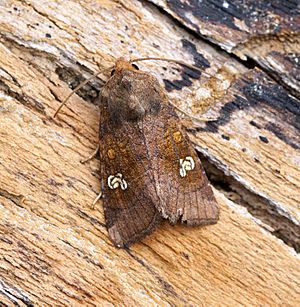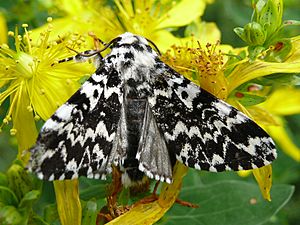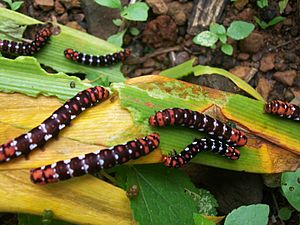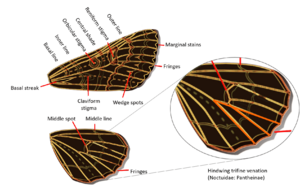Owlet moths facts for kids
Quick facts for kids Owlet moths |
|
|---|---|
 |
|
| Amphipoea oculea | |
 |
|
| Panthea coenobita | |
| Scientific classification |
|
| Kingdom: | Animalia |
| Phylum: | Arthropoda |
| Class: | Insecta |
| Order: | Lepidoptera |
| Superfamily: | Noctuoidea |
| Family: | Noctuidae Latreille, 1809 |
| Type species | |
| Noctua pronuba |
|
| Subfamilies | |
|
|
| Diversity | |
| About 11,772 species | |
The Noctuidae, often called owlet moths, are a very large family of moths. You might also hear them called cutworms or armyworms. For a long time, they were thought to be the biggest family of moths and butterflies (Lepidoptera). But now, another family called Erebidae holds that title.
Currently, the Noctuidae family is the second largest in its group, with about 1,089 different types (genera) and 11,772 species. Scientists are still learning about these moths, so their classification might change more in the future!
Contents
What Do Owlet Moths Look Like?
Adult Moths
Most adult owlet moths have dull-colored wings. But some, like those in the Acronictinae and Agaristinae groups, can be very colorful, especially in tropical places.
A special part of their body, called the nodular sclerite, helps protect their ears (tympanal organ) from tiny parasites. Their back wings also have a unique pattern of veins.
Caterpillars (Larvae)
Owlet moth caterpillars are usually green or brown. However, some species, like the camphorweed cucullia moth, have bright colors. Most are plump and smooth with small, round heads and not many hairs. But there are some exceptions!
Pupae
The pupae (the stage between caterpillar and adult moth) are usually shiny brown to dark brown. When they first turn into pupae, they are a bright orange-brown, but they get darker after a few days.
Eggs
Owlet moth eggs come in different colors, but they are all round.
Where Did Their Name Come From?
The name "Noctuidae" comes from the word "Noctua," which is Latin for "little owl." This is why they are often called "owlet moths."
The common names "armyworms" and "cutworms" describe how some of their caterpillars behave. They can gather in huge groups, like an army, and "cut" down plant stems, causing a lot of damage.
Where Do Owlet Moths Live and What Do They Do?
Distribution and Diversity
You can find owlet moths all over the world, except in the coldest parts of Antarctica. Some species, like the setaceous Hebrew character, even live in very cold places like the Arctic Circle in Canada! They can survive in temperatures as low as -25°C (-13°F). Some dart moths have been found high up in mountains, over 4,000 meters (13,000 feet) above sea level.
North America and northern Mexico are home to about 2,522 species of owlet moths. Europe has about 1,576 species, and the rest are spread across the globe.
Working Together (Mutualism)
Like other butterflies and moths, owlet moths help pollinate plants. This means they help plants make seeds by moving pollen from one flower to another.
Some species have a special relationship with certain plants. For example, the lychnis moth has a unique partnership with pink or carnation plants. The caterpillars eat the plant's seeds, while the adult moths help pollinate the flowers!
What Do Owlet Moths Eat?
- Eating Plants (Herbivory): Most owlet moth caterpillars eat plants. Some can even eat poisonous plants without getting sick! For instance, the splendid brocade moth caterpillar eats cowbane, a plant that is very toxic to many animals.
- Eating Other Insects (Predation) and Each Other (Cannibalism): Some caterpillars, like the shivering pinion, eat other insect larvae. Many owlet moth caterpillars, such as the fall armyworm, even eat their own brothers and sisters, or other types of caterpillars!
- Drinking Nectar and Puddling: Many adult owlet moths visit flowers to drink nectar. They also look for other liquids like plant juices, honeydew (a sweet liquid made by some insects), animal waste, and mud. This is called "puddling."
How Do Owlet Moths Reproduce?
Owlet moths usually start their breeding season from spring to fall. Many species, like the eastern panthea moth, can have several groups of offspring (broods) throughout the year. This is called being "multivoltine." However, some species, like the lesser yellow underwing, only have one brood of offspring each year. This is called being "univoltine."
Female moths release special scents called pheromones to attract males. Scientists have studied female pheromones for a long time, but they are still learning about male pheromones.
How Do Owlet Moths Defend Themselves?

Owlet moths have many ways to protect themselves, both with chemicals and physical features.
- Chemical Defenses:
- Some owlet moths, like the Spanish moth, can store special chemicals from the plants they eat.
- Others, like the Trachosea champa caterpillar, can produce formic acid, which is a strong chemical.
- The cabbage palm caterpillar can even spit up a toxin called toluquinone to scare away predators.
- Physical Defenses:
- Many owlet moths use mimicry, meaning they look like something else to hide. Most have dull colors and patterns that help them blend in with their surroundings (camouflage).
- Some caterpillars have thousands of tiny hairs (setae) all over their bodies for protection.
- Others use warning colors (aposematism) to tell predators they are dangerous or taste bad.
- All adult moths have a special ear (tympanal organ) that can hear the sounds bats make. This helps them avoid being caught by bats.
Why Are Owlet Moths Important to Humans?
Agriculture
Many owlet moth species cause problems for farmers around the world. Their caterpillars, known as "cutworms" or "armyworms," can form huge groups that destroy crops, fruit trees, and gardens every year.
For example, the Old World bollworm caterpillar causes over US$2 billion in damage to agriculture each year. The variegated cutworm is also known as one of the most harmful pests to vegetables. In West Africa, several owlet moth species are major pests of important crops like pearl millet, sorghum, and maize.
How Are Owlet Moths Classified?
Scientists are always studying how different living things are related. For owlet moths, recent studies show that they form a "monophyletic" group. This means they all share a common ancestor. Their classification is based on features like the veins in their wings.
The Noctuidae family includes many different groups, called subfamilies. Here are some of them:
- Plusiinae
- Bagisarinae
- Eustrotiinae
- Acontiinae
- Pantheinae
- Dilobinae
- Balsinae
- Acronictinae
- Metoponiinae
- Cuculliinae
- Amphipyrinae
- Oncocnemidinae
- Agaristinae
- Condicinae
- Heliothinae
- Eriopinae
- Bryophilinae
- Noctuinae
- Hadeninae
- Raphiinae
- Eucocytiinae
Images for kids
-
Calophasia lunula, caterpillar
See also
 In Spanish: Noctuidos para niños
In Spanish: Noctuidos para niños








